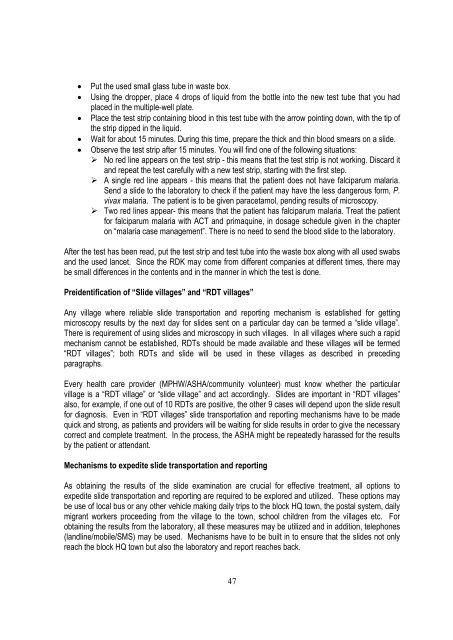training module for medical officers primary health centre - NVBDCP
training module for medical officers primary health centre - NVBDCP
training module for medical officers primary health centre - NVBDCP
- No tags were found...
Create successful ePaper yourself
Turn your PDF publications into a flip-book with our unique Google optimized e-Paper software.
Put the used small glass tube in waste box.Using the dropper, place 4 drops of liquid from the bottle into the new test tube that you hadplaced in the multiple-well plate.Place the test strip containing blood in this test tube with the arrow pointing down, with the tip ofthe strip dipped in the liquid.Wait <strong>for</strong> about 15 minutes. During this time, prepare the thick and thin blood smears on a slide.Observe the test strip after 15 minutes. You will find one of the following situations: No red line appears on the test strip - this means that the test strip is not working. Discard itand repeat the test carefully with a new test strip, starting with the first step. A single red line appears - this means that the patient does not have falciparum malaria.Send a slide to the laboratory to check if the patient may have the less dangerous <strong>for</strong>m, P.vivax malaria. The patient is to be given paracetamol, pending results of microscopy. Two red lines appear- this means that the patient has falciparum malaria. Treat the patient<strong>for</strong> falciparum malaria with ACT and primaquine, in dosage schedule given in the chapteron “malaria case management”. There is no need to send the blood slide to the laboratory.After the test has been read, put the test strip and test tube into the waste box along with all used swabsand the used lancet. Since the RDK may come from different companies at different times, there maybe small differences in the contents and in the manner in which the test is done.Preidentification of “Slide villages” and “RDT villages”Any village where reliable slide transportation and reporting mechanism is established <strong>for</strong> gettingmicroscopy results by the next day <strong>for</strong> slides sent on a particular day can be termed a “slide village”.There is requirement of using slides and microscopy in such villages. In all villages where such a rapidmechanism cannot be established, RDTs should be made available and these villages will be termed“RDT villages”; both RDTs and slide will be used in these villages as described in precedingparagraphs.Every <strong>health</strong> care provider (MPHW/ASHA/community volunteer) must know whether the particularvillage is a “RDT village” or “slide village” and act accordingly. Slides are important in “RDT villages”also, <strong>for</strong> example, if one out of 10 RDTs are positive, the other 9 cases will depend upon the slide result<strong>for</strong> diagnosis. Even in “RDT villages” slide transportation and reporting mechanisms have to be madequick and strong, as patients and providers will be waiting <strong>for</strong> slide results in order to give the necessarycorrect and complete treatment. In the process, the ASHA might be repeatedly harassed <strong>for</strong> the resultsby the patient or attendant.Mechanisms to expedite slide transportation and reportingAs obtaining the results of the slide examination are crucial <strong>for</strong> effective treatment, all options toexpedite slide transportation and reporting are required to be explored and utilized. These options maybe use of local bus or any other vehicle making daily trips to the block HQ town, the postal system, dailymigrant workers proceeding from the village to the town, school children from the villages etc. Forobtaining the results from the laboratory, all these measures may be utilized and in addition, telephones(landline/mobile/SMS) may be used. Mechanisms have to be built in to ensure that the slides not onlyreach the block HQ town but also the laboratory and report reaches back.47
















